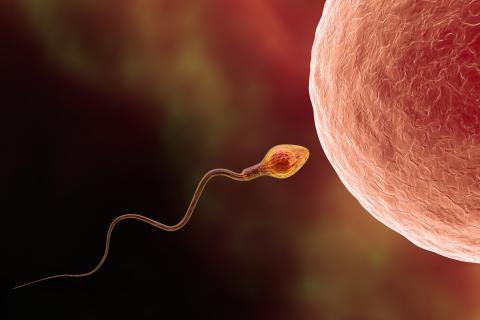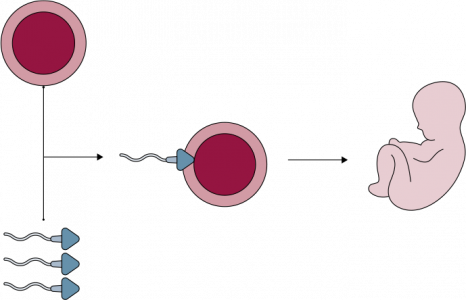
Explorations into the depths of the reproductive system
This article can also be found in L'Édition N.20.
Despite their differences, living organisms share a number of common functions. One of these is reproduction, a process that results in the creation of a new individual. Abstruse and sometimes mysterious, it fascinates many scientists at the Université Paris-Saclay.
Reproduction can be sexual or asexual: in the first case, it requires two individuals of different sexes and results in the birth of an individual with new genetic material; in the second, an individual produces a “copy” of itself. In humans, as in every other mammals, reproduction is sexual: it requires two reproductive cells, one male gamete (spermatozoon) and one female gamete (egg), which carry the genetic information of the parent individuals. When the two gametes meet, fertilisation occurs: the egg and sperm fuse into a cell called an egg, which then divides. The embryo thus formed then becomes a foetus which develops until the new individual is born.
However, reproduction can sometimes break down, especially in humans. In the Human Reproduction and Animal Models (RHuMA) team of the Biology of Reproduction, Environment, Epigenetics and Development laboratory (BREED – Univ. Paris-Saclay, UVSQ, INRAE, ENVA), François Vialard is studying the cellular and molecular mechanisms at the origin of dysfunctions of the reproductive system. “Our work consists of identifying genetic anomalies and then proposing therapies to circumvent them. We are working hard on the genetics of male infertility and, in this case, on meiotic arrest,” the researcher explains.
Meiosis is a process of cell division involved in the formation of gametes. Meiotic arrest can lead to azoospermia, being the absence of sperm in the ejaculate, and thus to infertility. “At the moment, we have only just demonstrated the existence of genetic alterations, which cause the anomalies. The problem must now be circumvented. The origins of these anomalies affect only one gene. If we are able to repair the anomaly in the gene, then it disappears,” the researcher adds.
The team led by François Vialard is also interested in cases of recurrent miscarriage, with the idea that “the female gamete would be the origin of chromosomal or aneuploid anomalies in the embryo”. The scientists in the RHuMA team are working on many other projects concerning the reproductive system. In particular, the team has developed a placental perfusion model to observe the transplacental passage of therapeutic molecules, particularly against cancer. The first uterus transplant in France was made possible in Suresnes following these studies.
Linking reproduction to mathematics
Based at the Inria Saclay centre, the Inria-INRAE-CNRS Multiscale population dynamics for physiological systems (MUSCA) project-team approaches the question of reproduction from a captivating angle: that of mathematical modelling. “The ovarian function is an eminently dynamic system, which today is mainly observed in a sampled, ad hoc way and generally from different individuals. We need a dynamic reconstruction,” explains Frédérique Clément, who cofounded MUSCA. “Reproduction is also finely controlled by interactive participants, including hormonal ones: everything becomes extremely counter-intuitive. Modelling makes it possible to reconstruct coherence.” The ovarian follicle, the multi-cellular structure in which the oocytes (future eggs) are brought to maturity, is at the heart of the studies carried out by the scientists in the MUSCA team.
“Our work either consists of finely characterising the evolution of a follicle during its development, in terms of structural development and cell dynamics, or to follow the evolution of the follicle population, representing each one by a marker summarising its maturity (its diameter, for example). Our aim is to merge these two approaches,” adds Frédérique Clément.
Led within MUSCA by Romain Yvinec, the OVOPAUSE collaborative project is attempting to answer the major questions raised by follicular dynamics by adopting a comparative physiological approach between different species. “It is by comparing different systems that we can extract the mechanisms that are specific and essential to the dynamics observed. The primary objective of OVOPAUSE is to explain the evolution of the female gamete population over the entire life span of an individual,” adds the researcher. The project focuses on the reproductive systems of mice and medakas, small fishes from Southeast Asia. “Several studies have already been carried out on the evolution of gamete populations over the ovarian cycle, but much less over the entire life span. We know that these dynamics begin at birth, even in the embryo. Events occurring very early in an individual’s life can have consequences for their reproductive status,” continues Romain Yvinec.
Like humans, the mouse is a mammal with so-called non-renewable, or quasi-renewable, folliculogenesis (processus of follicle creation): the stock of follicles built up at the perinatal stage decreases continuously during the individual’s life. For female medakas, on the other hand, have asynchronous ovogenesis: the folliculogenesis is renewed by a sustainable production of new gametes. “Our aim is to compare these two strategies in mathematical models, in order to explore how organisms manage a stock of gametes or its renewal over an individual’s lifetime,” concludes the researcher.
Ultimately, research in the field of reproductive biology will provide a better understanding of this complex process and the development of strategies for the diagnosis and management of reproductive disorders.
Publications :
- Baillif G. et al., Averaging of a Stochastic Slow-Fast Model for Population Dynamics: Application to the Development of Ovarian Follicles, SIAM Journal on Applied Mathematics, 82 (1), 2022.
- Capron C. et al., Evidence for high breakpoint variability in 46, XX, SRY-positive testicular disorder and frequent ARSE deletion that may be asso-ciated with short stature, Andrology, 10 (8), 2022.

